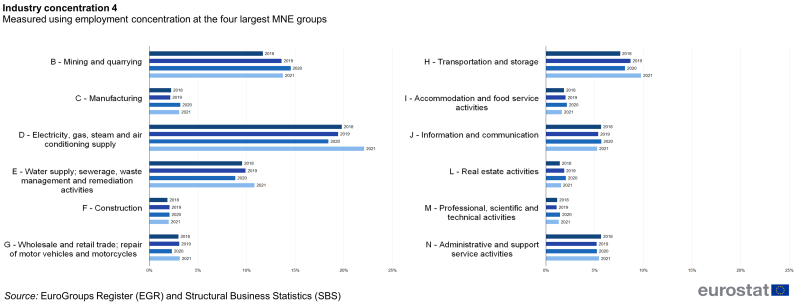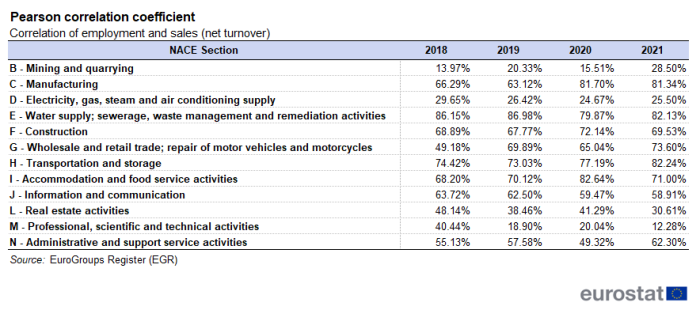EuroGroups Register and industry concentration
Data extracted in November 2023.
No planned article update.
Highlights
In the EU, some industries show concentration indices above 10 %, meaning that the largest four multinational enterprise groups control more than 10 % of the production.
This article gives an overview of industry concentration in the European Union (EU) calculated on the basis of the EuroGroups Register (EGR) data. Industry concentration indices measure the extent to which industry sales are dominated by one or more businesses.
EGR data and the information on the structure of the multinational enterprise groups make it possible to calculate concentration indices for the groups in the EU.
This article presents the concentration indices of twelve industries (NACE sections B to N, excluding K), using information on employment, as a proxy for sales. The results show, among others, that in the transportation and storage industry, the four largest multinational enterprise groups control around 10 % of the whole European industry, while the construction and real estate industries present a very low concentration index.
Full article
Introduction
Industry concentration is an interesting topic from the policymaker’s point of view. The EuroGroups Register (EGR) offers a unique approach to measure concentration as it contains the group structure of multinational enterprise groups that operate within the European Union and the European Free Trade Association territory. With this information, enterprises that could appear to compete in a certain industry as independent actors, can be identified as working under the umbrella of the same multinational enterprise group and thus, operating towards the same objective of group level profit maximisation. This means that when the enterprises of the same enterprise group are treated together, the concentration increases.
Data are released as experimental statistics because of the experimental nature of the primary data source used, the EuroGroups Register, which is in the experimental phase. In addition, the calculation of the concentration indices is based on employment and not on sales (or net turnover). In order to improve the analysis, a better coverage of the data on net turnover in EGR is necessary. Work is on-going and efforts are focused on the largest multinational enterprise groups, which have a major impact on the economy. The objective is to produce a regular time series (annual or bi-annual) of industry concentration indices at NACE division level and at European level, based on EGR net turnover and employment micro level data of the largest multinational enterprise groups.
The industry concentration is defined as a measure of the extent to which industry sales are dominated by one or more businesses. Concentration can be analysed at different geographical levels, e.g. national, European or global. In this article, an industry is defined at the section level of the statistical classification of economic activities in the European Community (NACE) and the concentration is analysed at EU level.
A high concentration is identified when a small number of companies control a large share of the industry, and it can be captured by, for example, calculating the four-firm concentration ratio, which includes the total sales of the largest four companies in the industry.[1]
The EGR does not contain data on sales and, as net turnover is not available with sufficient coverage yet, data on employment have been used as a proxy. The analysis shows a strong correlation between employment and net turnover. To measure the correlation between the total sales and the employment figures, a subset of EGR data which contains both net turnover (sales) and employment has been used, and the Pearson correlation coefficient[2] at EU level and NACE section was calculated.
Correlation of employment and sales (net turnover)
For some industries, the correlation between net turnover (sales) and employment is very high (e.g. in manufacturing or water supply; sewerage, waste management and remediation activities) and it is also relatively stable over the observed period 2018 - 2021, thus, employment data instead of sales, can be considered a good proxy to measure the industry concentration of most of the NACE sections.
To measure the concentration indices of the different industries using the available data, data on total employment by NACE section of the largest four enterprises available from the EGR were compared with the total employment by NACE section in the EU, available from the structural business statistics (SBS), which include both domestic and multinational enterprises.
Since the EGR includes information on the enterprises that operate under the umbrella of the same multinational enterprise group, employment data are aggregated, under the assumption that those enterprises are not competing in the same industry but rather working together to maximise the group’s profit.[3]
Industry concentration indices in the EU
The results of the calculation of the four-firm concentration ratio for the EU can be observed in Figure 1:
Higher industry concentration values can be noted in NACE sections B – mining and quarrying, D – electricity, gas, steam and air conditioning supply, E – water supply; sewerage, waste management and remediation activities, and H – transportation and storage. They were relatively stable over the period 2018 – 2021. However, when considering the correlation between employment and sales (net turnover) presented in Table 1, sections B and D show a relatively weak correlation. This means that the concentration measured using the proxy variable employment, is less reliable in this industry. On the other hand, NACE sections where the concentration index is around 10 % (sections E and H) and the correlation between employment and sales (net turnover) is also strong, provide a more straightforward interpretation. A concentration index of 10 % means that the four largest multinational enterprise groups operating in that industry control 10 % of the entire industry production at EU level.
Feedback
To help Eurostat improve these experimental statistics, users and researchers are kindly invited to give us their feedback by email
Data sources
The EGR is the main source of the computation. The EGR is the statistical business register of the EU Member States and EFTA countries for MNE groups. It produces data in yearly cycles and covers microdata on the groups and their enterprises and legal units.
The EGR aims to register all MNE groups that have enterprises in EU Member States or EFTA countries, including European and non-European groups. The EGR does not cover all-resident enterprise groups – those with enterprises only in one country, and independent enterprises.
The EGR microdata help to explore the structure and impact of multinational enterprise groups in Europe. One can analyse group size, complexity, and employment patterns in European countries, together with their European influence.
The main value added of the EGR is the possibility to link different enterprises that work under the umbrella of the same multinational group. While in other domains, enterprises are usually treated separately, and thus, as competing players in the industry, with EGR, it is possible to treat them together as “working as one” instead of competing.
The EGR is a statistical business register that serves statistical purposes only. Access to EGR data is restricted to national statistical institutes and national central banks that produce official statistics in the EU Member States and EFTA countries. Because enterprises that are active in only one country are out of the scope of the EGR database, a complementary dataset is necessary to calculate market concentration indices. Eurostat’s structural business statistics was the perfect candidate.
Structural business statistics (SBS) describe the business economy through the observation of units engaged in an economic activity; the unit in structural business statistics is generally the enterprise. An enterprise carries out one or more activities, at one or more locations, and it may comprise one or more legal units. Enterprises that are active in more than one economic activity (plus the value added and turnover they generate, the people they employ, etc.) are classified under the NACE heading corresponding to their principal activity; this is normally the one which generates the largest amount of value added.
Structural business statistics contain a comprehensive set of basic variables describing business demographics and employment characteristics, as well as monetary variables (mainly concerning operating income and expenditure, or investment).
Structural business statistics cover the business economy, which includes industry, construction, and many services. Financial and insurance activities are treated separately because of their specific nature and the limited availability of most types of standard business statistics in this area. Structural business statistics do not cover agriculture, forestry, and fishing, nor public administration and (largely) non-market services, such as education or health.[4]
Limitations
It is also important to highlight the different limitations of the computation of the industry concentration indices:
The most important limitation is the use of employment as a proxy for net turnover, which is explained and analysed in detail in this article.
Industry concentration refers to the concentration of the production side, i.e. some multinational enterprise groups will be more focused on exports and the link between the production and the market side of the concentration is not always straightforward.
The results presented here show the industry concentration at EU level. However, it is important to mention that there can be heterogeneity between the different Member States as well as within the same NACE section. This means that although concentration is not observed at EU level, it could be possible to have concentration in some industries if only one Member State would be considered. In addition, looking at the NACE division could show concentration, while it is not observed at NACE section, e.g. no industry concentration is observed in C – manufacturing, but it could be possible to observe concentration in C29 - manufacture of motor vehicles, trailers and semi-trailers. Because of that, it could be relevant to consider further break downs in the future by country and possibly NACE division.
Context
Indicators of industry concentration can give policymakers and competition regulators a broad idea on whether an industry is competitive or not. High industry concentration could be an indicator of market failures and trigger some monitoring of the situation. To provide a comprehensive view to the public, Eurostat uses data available from several domains to better understand the industry situation in the European Union.
Direct access to
- Multinational enterprise groups methodological note
- Methodology on enterprise groups and registers is available in the Business registers Recommendations manual
- EuroGroups Register metadata (ESMS metadata file — egr_esms)
- Structural business statistics metadata (ESMS metadata file — sbs_esms)
- Regulation (EEC) No 696/1993 of 15 March 1993 on the statistical units for the observation and analysis of the production system in the Community (Summary)
- Regulation (EU) 2019/2152 of the European Parliament and of the Council of 27 November 2019 on European business statistics, repealing 10 legal acts in the field of business statistics
- Implementing Regulation (EU) 2020/1197 of 30 July 2020 laying down technical specifications and arrangements pursuant to Regulation (EU) 2019/2152 of the European Parliament and of the Council on European business statistics repealing 10 legal acts in the field of business statistics
Notes
- ↑ The 4 – firm concentration ratio presented in this article is one of the most common indicators in use. Similar measures regularly mentioned in the literature include the ten or twenty – firm concentration ratios. Other measures can also use the ratio between the dominance of the 1st and 2nd largest enterprise groups by sales.
- ↑ In statistics, the Pearson correlation coefficient measures the linear association between two variables, in this case, employment and turnover.
- ↑ In practice, one can consider the measures of industry concentration using the EGR data as a lower bound for the actual concentration. This means that, if a domestic-only enterprise group is one of the largest four companies by employment, then the industry would be even more concentrated than what is computed here.
- ↑ From 2021, structural business statistics includes some of the NACE Sections mentioned. However, for the sake of comparability with data from 2018 to 2020, these have been excluded from the article.

